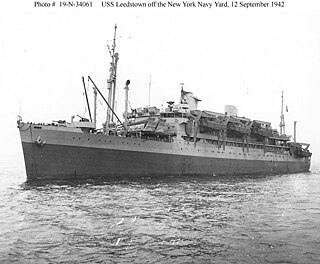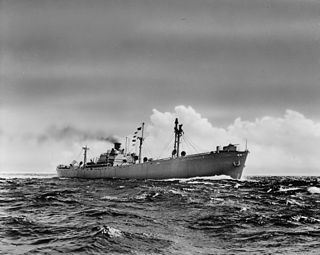
USS Susan B. Anthony (AP-72) was a turbo-electric ocean liner, Santa Clara, of the Grace Steamship Company that was built in 1930. Santa Clara was turned over to the War Shipping Administration (WSA) on 28 February 1942 and operated by Grace Lines as agent for WSA as a troop ship making voyages to the South Pacific. The ship was chartered to the Navy on 7 August 1942 for operation as a United States Navy transport ship. The ship was sunk 7 June 1944 off Normandy by a mine while cruising through a swept channel with all 2,689 people aboard being saved.

SS Absaroka was a steamer, named after the Absaroka Range of mountains in Montana and Wyoming, completed in February 1918 for the United States Shipping Board (USSB) which briefly operated the ship. From 17 September 1918 to 4 March 1919 the ship was commissioned as USS Absaroka with the identification number IX-2581 in United States Navy and operated by the Naval Overseas Transportation Service.

The War Shipping Administration (WSA) was a World War II emergency war agency of the US government, tasked to purchase and operate the civilian shipping tonnage the United States needed for fighting the war. Both shipbuilding under the Maritime Commission and ship allocation under the WSA to Army, Navy or civilian needs were closely coordinated though Vice Admiral Emory S. Land who continued as head of the Maritime Commission while also heading the WSA.

SS A. B. Hammond was a liberty ship built by California Shipbuilding Corporation of Los Angeles, and delivered in February 1944, to the War Shipping Administration (WSA).

SS A. Frank Lever was a Liberty ship built in the United States during World War II. Her namesake was A. Francis "Frank" Lever. Her sponsor was Mrs. A. Frank Lever.

USS Inca, a 3,381-ton "Liberty" ship, was launched in March 1943 at Los Angeles, California, and entered merchant service later the same month as SS William B. Allison, MCE hull 724. Two years later she would be taken into US Navy as stores ship and renamed USS Inca (IX-229). For much of her service as Inca she was also named USS Gamage (IX-227) because of bureaucratic confusion.

Booker T. Washington was a United States Maritime Commission (MC) Liberty ship and the first major oceangoing ship and first of 17 Liberty ships that were named after African-Americans. The ship was named for Booker T. Washington, notable educator, author, orator, and advisor to presidents of the United States. At launch Mary McLeod Bethune gave the address and notable singer Marian Anderson christened the ship.
USS Nausett (IX–190) was a tanker serving as an auxiliary ship in the United States Navy during World War II. Built as W. M. Irish the ship was a commercial tanker until taken by the War Shipping Administration (WSA) during World War II. WSA first allocated the ship to the Army and then as lend lease to the Soviet Union where the ship was renamed Moskva. On return the ship was renamed Nausett and allocated to the Navy which first accepted the vessel and then found it too expensive to make suitable. The ship was returned to WSA, placed in reserve and sold for scrap the next year.

USS Mizar (AF-12) was the United Fruit Company fruit, mail and passenger liner Quirigua that served as a United States Navy Mizar-class stores ship in World War II.

USS Merak (AF-21), the second Navy ship of the name, was the United Fruit Company cargo and passenger liner Veragua that served as a United States Navy Mizar-class stores ship in World War II.

USS Leedstown (AP-73), built as the Grace Line passenger and cargo ocean liner SS Santa Lucia, served as a United States Navy amphibious assault ship in World War II. The ship had first been turned over to the War Shipping Administration (WSA) and operated by Grace Line as the WSA agent from February to August 1942 in the Pacific. In August the ship, at New York, was turned over to the Navy under sub-bareboat charter from WSA. She was sunk 9 November 1942 off the Algerian coast by a German submarine after German bombers caused damage the day before.

USAHS Blanche F. Sigman was a United States Army hospital ship during World War II. The ship was completed in April 1943 as Liberty ship SS Stanford White. When selected for conversion to a hospital ship, she was originally assigned the name USAHS Poppy, but never operated under that name. After being decommissioned as a hospital ship, she became U.S. Army transport USAT Blanche F. Sigman.

USS George F. Elliott (AP-105) was a cargo liner built for the Mississippi Shipping Company as SS Delbrasil for operation between New Orleans and the east coast of South America in 1939 by its operator, Delta Line. The ship entered that service and operated until taken over by the War Shipping Administration (WSA) on 28 April 1942 for operation by Delta Line acting as WSA's agent. On 25 August 1943 WSA allocated the ship to the Navy for conversion to a troop transport commissioned and operated by the Navy for the duration of the war. Ownership of the ship was transferred from Mississippi Shipping to WSA on 4 February 1944 while under Navy operation and was retained until sale to American South African Lines on 22 December 1948. The ship was renamed African Endeavor until returned as a trade in to the Maritime Commission on 22 September 1960 for layup in the James River reserve fleet and later sold to Boston Metals for scrapping.

The Type C4-class ship were the largest cargo ships built by the United States Maritime Commission (MARCOM) during World War II. The design was originally developed for the American-Hawaiian Lines in 1941, but in late 1941 the plans were taken over by the MARCOM.

USAT Cuba was the passenger ship Cuba of the Peninsular & Occidental Steamship Company built by William Cramp & Sons Shipbuilding Company, Philadelphia in 1920 and placed into operation in 1921 for scheduled passenger and freight service between Tampa, Key West and Havana.

Corvus was a steam cargo ship built in 1919 by Columbia River Shipbuilding Company of Portland for the United States Shipping Board as part of the wartime shipbuilding program of the Emergency Fleet Corporation (EFC) to restore the nation's Merchant Marine. The freighter was operated on international and domestic routes through 1944. Early in 1945 she was transferred to Soviet Union as part of lend-lease program and renamed Uzbekistan. After several months of operation, the freighter was rammed by another vessel on 31 May 1945 and was beached to avoid sinking. She was subsequently raised and towed to Portland where she was scrapped in 1946.

Brown Victory was a Maritime Commission type VC2-S-AP2 Victory ship built during World War II under the Emergency Shipbuilding program. The ship was built by Oregon Shipbuilding Company Portland as Maritime Commission hull 171, yard number 1225. Her keel was laid on 25 February 1945. She was named for Brown University and christened on 2 May 1945. The ship was completed and delivered to the War Shipping Administration (WSA) with operation under WSA agreement by the Alaska Packers' Association on 27 March 1945. That agreement remained in effect until 2 July 1946.
SS Walter W. Schwenk was a Liberty ship built in the United States during World War II. She was named after Walter W. Schwenk, a World War I Navy veteran. Before World War II Schwenk worked with Blake Line, Consolidated Navigation Corporation, and Southgate–Nelson Corporation. In 1940, he joined the US Maritime Commission (MARCOM), and later the War Shipping Administration (WSA), February 1942. On 15 April 1944, he was appointed the Atlantic Coast director of the WSA, responsible for all cargo and ship movement on the East Coast.

The SS Harry Luckenbach, built as a cargo ship ordered by the Luckenbach Steamship Company and built at Sun Shipbuilding and Drydock Co. in Chester, Pennsylvania in 1919. The as yet unnamed ship was requisitioned by the United States Shipping Board (USSB) before completion and converted to a troop transport. The USSB allocated the ship, which had been fitted out with temporary troop accommodation in its cargo spaces, to the Navy which commissioned the ship on 7 July 1919 as USS Sol Navis with the Identification number 4031A. The ship was decommissioned October 1919 after two trips to France.

SS Anne Hutchinson was a Liberty ship built by the Oregon Shipbuilding Company of Portland, Oregon, and launched on 31 May 1942 The ship was named after the Anne Hutchinson, a 1600 Massachusetts Bay Colony Puritan.

















